
Konstantinos Kanaris, also anglicised as Constantine Kanaris or Canaris, was a Greek statesman, admiral, and a hero of the Greek War of Independence.
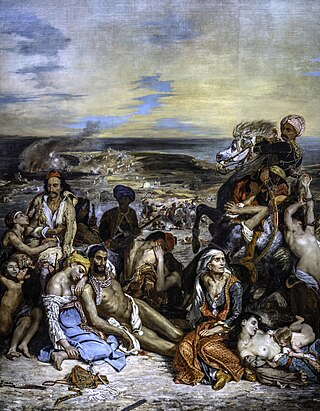
1822 (MDCCCXXII) was a common year starting on Tuesday of the Gregorian calendar and a common year starting on Sunday of the Julian calendar, the 1822nd year of the Common Era (CE) and Anno Domini (AD) designations, the 822nd year of the 2nd millennium, the 22nd year of the 19th century, and the 3rd year of the 1820s decade. As of the start of 1822, the Gregorian calendar was 12 days ahead of the Julian calendar, which remained in localized use until 1923.

The Greek War of Independence, also known as the Greek Revolution or the Greek Revolution of 1821, was a successful war of independence by Greek revolutionaries against the Ottoman Empire between 1821 and 1829. In 1826, the Greeks were assisted by the British Empire, Kingdom of France, and the Russian Empire, while the Ottomans were aided by their vassals, especially by the Eyalet of Egypt. The war led to the formation of modern Greece, which would be expanded to its modern size in later years. The revolution is celebrated by Greeks around the world as independence day on 25 March.

Psara is a Greek island in the Aegean Sea. Together with the small island of Antipsara it forms the municipality of Psara. It is part of the Chios regional unit, which is part of the North Aegean region. The only town of the island and seat of the municipality is also called Psara.

The Chios massacre was a catastrophe that resulted in the death, enslavement, and flight of about four-fifths of the total population of Greeks on the island of Chios by Ottoman troops during the Greek War of Independence in 1822. It is estimated that up to 100,000 people were killed or enslaved during the massacre, while up to 20,000 escaped as refugees. Greeks from neighboring islands had arrived on Chios and encouraged the Chiotes to join their revolt. In response, Ottoman troops landed on the island and killed thousands. The massacre of Christians provoked international outrage across the Western world and led to increasing support for the Greek cause worldwide.

Ibrahim Edhem Pasha (1819–1893) was an Ottoman statesman, who held the office of Grand Vizier in the beginning of Abdul Hamid II's reign between 5 February 1877 and 11 January 1878. He resigned from that post after the Ottoman chances on winning the Russo-Turkish War (1877–1878) had decreased. He furthermore served numerous administrative positions in the Ottoman Empire including minister of foreign affairs in 1856, then ambassador to Berlin in 1876, and to Vienna from 1879 to 1882. He also served as a military engineer and as Minister of Interior from 1883 to 1885. In 1876–1877, he represented the Ottoman Government at the Constantinople Conference.

The North Aegean islands are a number of scattered islands in the North Aegean Sea, also known as the Northeastern Aegean islands, belonging mostly to Greece and a few of them to Turkey. The islands do not form a physical chain or group, but are frequently grouped together for tourist or administrative purposes. To the south are the Dodecanese islands; and to the west are the Cyclades and Sporades islands.

The Destruction of Psara was the killing of thousands of Greeks on the island of Psara by Ottoman troops during the Greek War of Independence in 1824.

There were numerous massacres during the Greek War of Independence (1821–1829) perpetrated by both the Ottoman forces and the Greek revolutionaries. The war was characterized by a lack of respect for civilian life, and prisoners of war on both sides of the conflict. Massacres of Greeks took place especially in Ionia, Crete, Constantinople, Macedonia and the Aegean islands. Turkish, Albanian, Greeks, and Jewish populations, who were identified with the Ottomans inhabiting the Peloponnese, suffered massacres, particularly where Greek forces were dominant. Settled Greek communities in the Aegean Sea, Crete, Central and Southern Greece were wiped out, and settled Turkish, Albanian, Greeks, and smaller Jewish communities in the Peloponnese were destroyed.

The most important artistic movement of Greek art in the 19th century was academic realism, often called in Greece "the Munich School" because of the strong influence from the Royal Academy of Fine Arts of Munich, where many Greek artists trained. The Munich School painted the same sort of scenes in the same sort of style as Western European academic painters in several countries, and did generally not attempt to incorporate Byzantine stylistic elements into their work.

The Greek frigate Hellas was the flagship of the Revolutionary Hellenic Navy. After an arbitration hearing in New York due to financial default by the Greek government, she was delivered to Greece in 1826. She was burned in 1831 by the Greek Admiral Andreas Miaoulis when the government of Ioannis Kapodistrias ordered her turned over to the Russian navy.
Kara Mehmet Pasha was an Ottoman officer who became briefly Kapudan Pasha in 1822 during the Greek War of Independence.
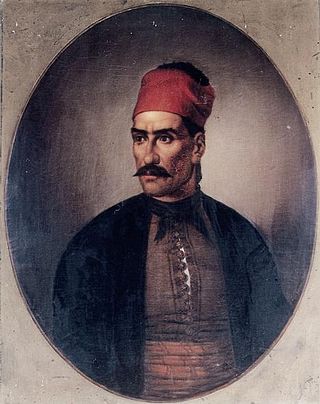
Anastasios Tsamados was a Greek admiral of the Greek War of Independence. He was the famous captain of the brig Aris and an admiral who led a naval squadron under Andreas Miaoulis. Anastasios Tsamados was the first to rush to the Greek island of Chios and attack the naval warships of the Kapudan Pasha during the massacre of Chios. He also fought in the naval battle of Patras (1822) and died heroically during the famous Battle of Sphacteria.
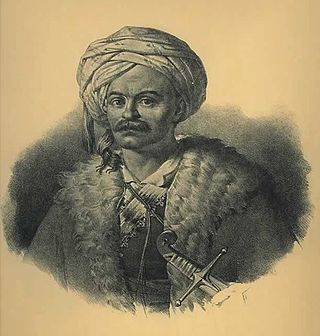
The Chios expedition was an unsuccessful attempt of the regular Greek army and irregular military units for the recapture of Chios island during the final stages of the Greek War of Independence. Chios had participated in the Greek uprising against the Ottoman Empire, but had been captured and its population massacred by the Ottoman fleet in 1822.

The Greek raid on Alexandria was an unsuccessful attempt organized by Greek bruloteer Konstantinos Kanaris to destroy the Egyptian fleet at its base in Alexandria in 1825 during the Greek War of Independence.

Nasuhzade Ali Pasha, commonly known as Kara Ali Pasha, was an Ottoman-Albanian admiral during the early stages of the Greek War of Independence. In 1821, as second-in-command of the Ottoman navy, he succeeded in resupplying the isolated Ottoman fortresses in the Peloponnese, while his subordinate Ismael Gibraltar destroyed Galaxeidi. Promoted to Kapudan Pasha, and led the suppression of the revolt in Chios and the ensuing Chios massacre in April 1822. He was killed when a fireship captained by Konstantinos Kanaris blew up his flagship in Chios harbour on the night of 18/19 June 1822.
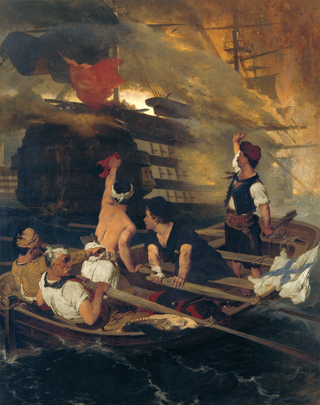
The burning of the Ottoman flagship off Chios took place on the night of 18 June 1822. The event, occurring during the Greek War of Independence, was a reprisal for the Chios massacre which occurred two months earlier. Two thousand Ottoman sailors were killed, as was Nasuhzade Ali Pasha, the Kapudan Pasha of the Ottoman Navy.

Benedetto Civiletti was an Italian sculptor, active mainly in his native Sicily. He is known for his Romantic-style public sculptures on allegorical, genre, or historical themes.
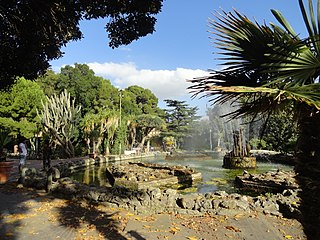
The Piersanti Mattarella Park, formerly the English Garden, is a public park in Palermo designed in 1851 by the architect Giovan Battista Filippo Basile.

Andreas Pipinos was a Greek military officer during the Greek War of Independence.






















